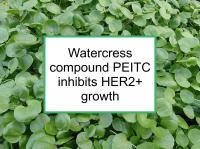Phenethyl isothiocyanate (PEITC), an isothiocyanate abundant in watercress and also found in some other cruciferous vegetables, has been shown to have chemopreventive effects in breast cancer studies. For example, PEITC has been shown to inhibit the growth of HER2+ mammary tumors in mice.
For example, PEITC has been found to (1) reduce the growth of hormone receptor positive (ER+/PR+), HER2 overexpressing (HER2+), and triple negative (ER-/PR-/HER2-) breast cancer cells; (2) decrease angiogenesis (the process by which tumors send out signals to induce surrounding normal tissues to grow new blood vessels into the tumor); and (3) enhance the sensitivity of breast cancer cells to doxorubicin chemotherapy and to radiotherapy.
Now a new study has reported that PEITC inhibits the growth and progression of HER2+ breast cancer by targeting breast cancer stem cells. PEITC combined with trastuzumab (Herceptin) also significantly reduces tumor development in transgenic mice designed to spontaneously develop HER2+ tumors.
Food sources of PEITC
Watercress is the richest source of PEITC. It is also found in brussels sprouts, garden cress, horseradish, turnips, mustard, rutabagas, and radishes. Watercress should be eaten raw rather than cooked to obtain the strongest anti-cancer effects.
Chemopreventive levels of PEITC can be obtained by including watercress and other cruciferous vegetables in the diet. It is inadvisable to consume PEITC supplements, cruciferous vegetable extracts, freeze-dried cruciferous vegetable powders or similar preparations. Concentrated sources of isothiocyanates can damage the DNA of normal cells. In fact, regular intake of PEITC has been shown to cause its buildup, resulting in cumulative effects, which could be toxic. One study reported that concentrated PEITC treatment increased the incidence of urinary bladder hyperplasia and tumors after they had been established in animals. PEITC appeared to have preventive effects before tumor development, but increased tumor incidence after the tumors had started to form.
Latest research shows how PEITC inhibits HER2+ disease
The study referenced above was designed to test the antitumor activity of PEITC, alone or in combination with trastuzumab, in cell and animal models of HER2+ breast cancer. In the cell studies, the authors measured the sphere forming efficiency HER2+ cancer cells. In the animal studies, the authors used mice implanted with MI6 tumor cells transgenic for human d16HER2 splice isoform. Magnetic resonance imaging/spectroscopy and immunohistochemistry were used to assess morpho-functional and metabolic profiles of treated compared to untreated mice. The authors also evaluated the expression of (1) the human/rodent cancer stem cell biomarkers aldehyde-dehydrogenase (ALDH) and CD29High/CD24+/Sca1Low (using cytofluorimetric analysis); and (2) wild type HER2 (WTHER2), its splice variant d16HER2 and NOTCH (using RT-PCR and Western blotting).
PEITC was found to significantly impair the sphere forming efficiency of HER2+ breast cancer cells by decreasing their ALDH-positive compartments. Comparable results were produced for ovarian cancer cells. PEITC also reduced the expression or activation of established cancer-stemness biomarkers. Similar results were obtained in MI6 cells, where PEITC, alone or in combination with trastuzumab, significantly inhibited sphere forming efficiency. In the mice, PEITC reduced the growth of MI6 tumors by inducing hemorrhagic and necrotic areas within them. In combination with trastuzumab, PEITC significantly reduced spontaneous tumor development in the mice. The authors conclude that PEITC targets HER2+ cancer stem cells and that PEITC combined with trastuzumab form the basis for development of a new therapeutic strategy for HER2+ tumors.
Please see our article on diet for HER2+ patients and survivors for more information.
